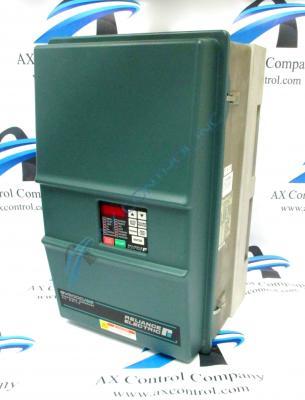About the 25V4251
This unit is a 25HP 3-Phase GV3000 style AC Drive by Reliance Electric. The 25V4251 was probably also mass-produced by Baldor Reliance or ABB depending on the manufacturing dates for this drive.
The 25V4251 is 380-460 VAC 50/60 Hz and 35 KVA. It has a standard input amperage of 44 and an output of 39 amps. It has a power loss wattage of 800. This drive weighs 23.6 kg and is 350 mm thick, 605 mm tall, and 376 mm wide. This device should only be operated in temperatures between 0 to +40 degrees Celsius. The recommended fuse rating for this drive is a 70-amp fuse.
This device is enclosed by a NEMA 12 chassis. The 25V4251’s chassis is only meant for inside applications. It is not vented for airflow and has a dust and drip-tight seal. It is important to keep this device away from corrosive substances.
The 25V4251 can be mounted to a panel or other flat surface. Nothing should be mounted behind it. There are a series of 4 factory-drilled holes on the backplane of the drive. The user should use M8 or M10 bolts and washers to maintain a tight mount on the panel. This mounting hardware is sold separately. To maintain compliance, it is important to follow all NEC/CEC and local wiring codes for this drive. There is a terminal strip on the regulator where the user can wire I/O connections. There are power terminal strip and ground terminals that are located below that. On the bottom of the drive is a set of four wire routing locations. This GV3000 series drive also offers two places for signal control; a place for input power or snubber resistor braking, and a place for motor leads or a combo of input power and motor leads.
While the 25V4251 offers an array of specifications consistent with AXcontrol's lofty standards, even the most diligent users of this drive may encounter the occasional fault. One fault that may possibly derail the efficient production of this GV3000 AC drive is the non-volatile memory write failure fault, represented on the drive's built-in display interface by the code EEr. The EEr fault can be caused by a failure to write on non-volatile memory, and corrective action when faced with this fault can be limited to connecting CS3000 software to upload parameters or record by hand, followed by a subsequent regulator board replacement. It is important to note that existing parameter values will be lost when the drive's power is fully cycled. For more information on fault codes and drive error troubleshooting, please make use of Reliance Electrics' comprehensive instruction manual D2-3359 & D2-3360.












